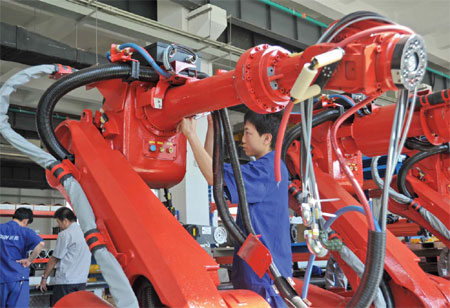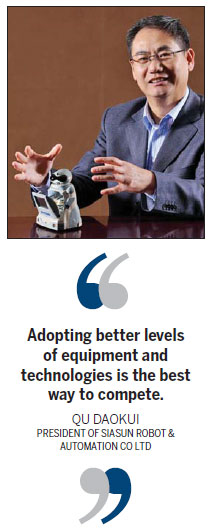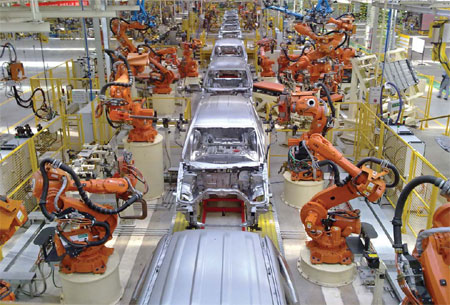Hortiplan
Demtec
Azahari Che Rani
Official Site
Saturday, 20 October 2012
Azahari Che Rani studies "China’s Siasun robot maker"
Siasun's metallic touch
Updated: 2012-10-05 08:53
By Zhong Nan and Wu Yong (China Daily)
| |||||||||||

Siasun Robot & Automation Co Ltd is a beneficiary of an increasing use of robots by manufacturers in China due to rising labor costs. Provided to China Daily
|
With labor shortages spreading across china, company expands production of industrial robots
One competitive Chinese company is looking to make up for the nation's intermittent labor shortages with workers that most likely will not complain or demand higher pay.
Siasun Robot & Automation Co Ltd, China's largest robot maker by market value, is seizing on the chance to help companies crippled by more expensive labor that has made China such a dominant force in the global economy. It is currently building two factories in Hangzhou and Shenyang, capitals of Zhejiang and Liaoning provinces, both of which are located on the nation's east coast.
 |
The Shenyang-based robot maker sold 3,000 industrial robots in both China and to overseas markets last year, most to automotive companies. Total sales revenue reached 700 million yuan ($110.93 million, 85.91 million euros). Sales to the United States, Canada, France, Singapore and another nine countries accounted for 200 million yuan in sales last year.
Currently, the company operates seven factories that are involved in production as well as research and development in Shanghai, Beijing, Guangzhou, Shenzhen and three other Chinese cities.
With an investment of 200 million yuan, Siasun's Hangzhou project will be completed next year. Its Shenyang project is expected to be operational in 2013.
The number of Siasun employees is expected to increase from a current workforce of 1,500 to 4,000 by the end of 2015.
"Companies from Europe, Japan and the US once dominated the Chinese market, but imported robotic equipment often failed to fully meet the needs of Chinese factories, as the component and maintenance costs are too high," says Qu Daokui, Siasun president.
Founded in 2000, Siasun initially focused on producing industrial robots for China's fast-growing automobile market. A production line at an auto company with an annual capacity of 100,000 to 200,000 cars needs about 600 robots.
"In comparison with foreign-made robots, we have more knowledge about what our (Chinese) clients want and how to set up several programs for one production line operated by robots in their plants. It also costs less to send our engineers to different locations in China to solve (mechanical robot issues) within 24 hours," Qu says.
The average price for an industrial robot is about 200,000 yuan to 500,000 yuan. Some robots are pricier, such as the ones used in aircraft manufacturing, which can cost up to a million yuan.
Last year, Chinese companies bought more than 22,000 robotic products, with about 52 percent of them used in the automobile industry, according to the China Association of Automobile Manufacturers. Chinese carmakers such as Geely Automobile, BYD Auto and Great Wall Motors have equipped their factories with robots and increased the number of robots to improve efficiency in what is usually a grueling work environment.
"There is no need to become an expert to discover the quality gap between Chinese cars and vehicles made by foreign companies like Volkswagen, Audi or Toyota," Qu says. "Adopting better levels of equipment and technologies is the best way to compete."
The company's main automaker partners in China are Ford Motor Co, SAIC Motor, Brilliance Auto, Mazda Motor Corp and Dongfeng Motor Corp.
Siasun is investing 70 million yuan in research and development this year to provide advanced robotics to the automobile industry. The company is delivering 28 spot welding robots to China FAW Group Corp, one of China's top four automakers.
The company is also one of the suppliers of automated guided vehicles, a mobile robot that follows markers or wires on the floor, to Shanghai General Motors.
Most of the automated guided vehicles are powered by batteries and installed with security protection and auxiliary devices. They are commonly used in industrial applications to move materials around a manufacturing facility or a warehouse.
Siasun exported 42 automated guided vehicles robots to General Motors' headquarters in the US in 2010.
Siasun has also received a high volume of inquiries from traditional factories that are interested in robotic assistance, including clothing factories, shoemakers and electronics producers located in the Pearl River Delta, Yangtze River Delta and the Bohai Bay region.
"Robots never complain and ask for pay rises and factory owners can profit in several years. It is the trend that robots will replace a number of mechanic work positions over the next three years," says Ha Enjing, head of Siasun's branding and public relations department.
"We are also providing automated products and solutions to State-owned enterprises such as building automated power stations to charge electronic vehicles for the State Grid Corporation of China in Beijing, automated warehouses for China Shenhua Energy Co Ltd in Gansu and the Ningxia Hui autonomous region, and Daqing Oilfield Co Ltd in Heilongjiang province," she says.
In 2011, China invested about 10.3 trillion yuan to upgrade the manufacturing sector, up 31.8 percent from 2010, according to the National Bureau of Statistics. The majority of that spending resulted in newer and better factories.
"What you find is a high level of investment in Chinese manufacturing, but most of this is not going to expanding production capacities. It's making them more efficient and advanced," says Zhao Ying, a researcher at the Institute of Industrial Economics of the Chinese Academy of Social Sciences.
"Chinese robot makers should accelerate the speed of making breakthroughs in technology and concentrate the funds and human resources to develop key components such as actuators, sensors, hydraulic equipment and optimizing the production process to support industrial growth," Zhao says.
Zhao says Chinese companies need to understand that having the wherewithal to make robots is of itself not enough. Putting them to efficient and effective use depends on having qualified and skilled engineers thoroughly familiar with robot and systems integrations technology.
Azahari Che Rani studies "The rise of the robots"
The rise of the robots
 |
Azahari Che Rani studies "China’s Siasun robot maker"
China’s Siasun Expands To Seize More Of The Domestic Market

Rising labor costs and the expense of maintaining foreign robots gives the Chinese manufacturer a boost
By RBR Staff
0
October 08, 2012
According to China Daily, Siasun Robot & Automation Co Ltd, China’s largest robot maker by market value, is seizing the chance to help Chinese companies crippled by more expensive human labor. Siasun is expanding its facilities and product offerings to accommodate growing domestic demand.
Currently, the company operates seven factories that are involved in production as well as research and development in Shanghai, Beijing, Guangzhou, Shenzhen and three other Chinese cities. It is building two additional factories in Hangzhou and Shenyang, capitals of Zhejiang and Liaoning provinces.
The Shenyang-based robot maker sold 3,000 industrial robots in both China and to overseas markets last year, most to automotive…
This is a preview article. Please register to view the entire article.
Azahari Che Rani studies "Japanese first responders to wear robotic exoskeletons"
Japanese first responders to wear robotic exoskeletons
October 18, 2012

Professor Yoshiyuki Sankai presents the modified HAL exoskeleton during Japan Robot Week 2012
Image Gallery (5 images)
Robotic Subsea Equipment - www.MechanicsDesign.com
Industrial Instrumentation Winches, Pressure Housings, Custom Manifolds
Ads by GoogleIndustrial Instrumentation Winches, Pressure Housings, Custom Manifolds
Since the Fukushima Daiichi nuclear disaster in March 2011, the Japanese government has been testing robotic technologies to help deal with future accidents. The Hybrid Assistive Limb (HAL) exoskeleton, developed by the University of Tsukuba spin-off Cyberdyne, is being considered for first responders.
For protection the suit incorporates tungsten shielding which reduces radiation exposure by about 50 percent, as well as a cooling system to prevent heatstroke. Much of the weight of the suit, including tools used for repairing damaged pipes, can be carried by the exoskeleton's legs. Vital signs such as heart rate and body temperature will also be measured in real-time.
As part of the same initiative, the Chiba Institute of Technology (CIT) is developing remotely-operated robots that can enter radioactive areas. CIT researchers have already built two generations of search-and-rescue robots, which have been tested in annual competitions like the RoboCup Rescuechallenge. Their latest unmanned robot, Sakura, can be used to inspect pipes, radiation levels, temperature, humidity, among other things. It negotiates stairwells and narrow passages by moving on tank-like treads and is equipped with a camera and other sensors. The team expects the robot to be maintenance-free for three years after carefully selecting build materials, which will further help reduce radiation exposure.
The New Energy and Industrial Technology Development Organization (NEDO) says the robots will be unveiled to the public in the coming days during Japan Robot Week 2012. In the future a mock-up facility will be built where further research and development can be done. Until now Cyberdyne has marketed the HAL suit as a walking aid (and for rehabilitation), though the company has also shown it with an upper-body extension that multiplies the wearer's lifting strength by a factor of 10. And, with further miniaturization, it is expected that Sakura may go just about anywhere within a reactor building.
The Japanese government has been widely criticized for its lack of preparedness in the face of nuclear accidents, including its reliance on foreign robot technology (remote-controlled Warrior robots developed byRoomba maker iRobot trumped their own systems). However, the Japanese government has actually invested millions into related technologies, with the cooperation of industry giants and academia, since the 1980s.
Source: NEDO press release (Japanese) via Robonable (Japanese)
Azahari Che Rani studies "Robot Industry Soars Beyond KRW 2 Billion in 2011"
Robot Industry Soars Beyond KRW 2 Billion in 2011
Thursday, July 19th, 2012
SEOUL, KOREA — According to the Ministry of Knowledge Economy, Korea’s robot production in 2011 reportedly doubled 2010’s figure. Export in the same year also went up two times higher than its previous year 2010.
On July 18, the Ministry’s “Robot Industry Report in 2011“on all 363 robot makers revealed that their overall production rose 20.3% to KRW 2.15 Trillion compared to the previous year, despite slow growth. Defying difficulties at home and abroad, robot production in the manufacturing area grewKRW 1.65 Trillion. Domestic output increased 1.6% and export up 195.2%.
Robots for service use expanded 13.4%, riding on the back of the growth of personal service sectors: robots for home use at KRW 1701 Billion, Education and Research 530 Billion Won, and Healthcare 65 Billion Won. Following the trend, production in robot parts has also jumped 86.1% since the same quarter in 2010.
Export’s doubled-increase depended heavily on Manufacturing and cleaning robots at 5211 Billion Won, while its import up 21 % stood at KRW 3308 Billion.
Last year, trade deficit at KRW 439 Billion in 2010 turned around with a surplus gap KRW 1463 Billion. And the number of active companies in the industry has been added from 334 in 2010 to 346, which was coincided with the employee figure up 15.1% at 10,509 from 9129 in 2010.
Azahari Che Rani studies "Korean robotics industry bursting into bloom"
Korea's robotics industry is making rapid headway as local developers chalked up record growth in output, sales and exports last year on the back of surging investment in factories, a government study showed Tuesday.
According to the survey by the Korea Association of Robot Industry of 395 firms, their combined sales nearly doubled to 1.93 trillion (S$2.123 billion) last year from a year earlier. Total production volume and exports shot up 75 per cent and 137 per cent to around 1.78 trillion won and 229 billion won, respectively.
Of the total output, industrial robots such as for carrying, loading, assembling and welding took the biggest slice with almost 80 per cent, up 70 per cent compared with 2010.
A spike in facility investment by local manufacturers, coupled with the expanding role of robots on production lines, largely drove up demand, said the Ministry of Knowledge Economy, which compiled the data.
"(The robotics industry) tends to be affected by facility investment because industrial robots are regarded as part of assembly lines," a ministry official said. "Government subsidies and pilot projects play a big part as well."
Harnessing Korea's advanced technologies in electronics and telecommunications, the government has been looking to bolster the nascent sector since 2002 as one of growth engines along with autos, semiconductors and displays.
In January, seven ministries involving industry, education and the environment devised a plan to pump 100 billion won into 10 pilot projects to develop and utilize service and industrial robots by 2013.
Under the plan, robots will be deployed for education, fire-fighting, sewage repairs and manufacturing this year, while others patrol danger zones, remove mines in the DMZ and do farm work starting next year, the Ministry of Knowledge Economy said.
"This pan-governmental plan will be a stepping stone for Korean developers to play a leading role in the coming era of robotics revolution," said Cho Seok, the ministry's chief of growth engines division.
The latest study also highlights stellar growth in the service robot market. Though its share is only about 10 per cent, the segment expanded by a whopping 562 per cent in a year to almost 100 billion won.
Service robots generally assist humans with domestic and office chores and other professional tasks including surgery, navigation, milking, teaching, demining and military patrol operations.
In December, the ministry unveiled a comprehensive package to fund 30 billion won for the commercialization, standardization and marketing for the high value-added helpmates by 2017.
Although it has teetering on the brink of the global economic slowdown, the local robot market has still managed to expand at double-digit rates every year since 2006, according to the state-run Korea Institute for Robot Industry Advancement.
Korea is the world's No. 4 robot producer after Japan, Germany and the U.S. The International Federation of Robotics projects the global market to reach $100 billion in 2018.
In its annual report, the Frankfurt-based organization picked Korea as the world's top robot buyer in 2010, with demand almost tripling in a year.
"The most dynamic markets were China, Korea and the ASEAN countries," it said, noting that robots in the automotive, electronics, food and metal industries are boosting the automation levels in the regions and worldwide.
Subscribe to:
Posts (Atom)









